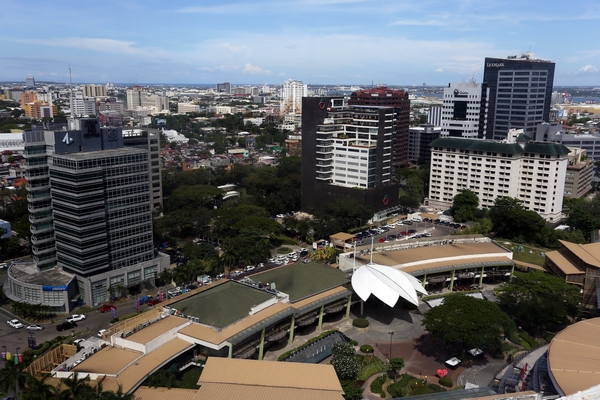
High-rise buildings in a business district in Cebu City are among the infrastructure that help fuel Cebu City’s businesses. CDN FILE PHOTO
IMPROVING CEBU CITY’S COMPETITIVENESS
Better collaboration among the private sector and government should be done if Cebu City wants to improve on its competitiveness ranking.
Cebu Business Club (CBC) President Gordon Alan Joseph said that platforms like the Mega Cebu, a multi-sectoral consortium of private sector and government stakeholders created in 2011, is a good way to promote this collaboration.
“It is obvious that there is room for improvement and I believe that while Cebu is economically vibrant, it is definitely not world class or near globally competitive,” Joseph said.
He gave the statement in reaction to Cebu City’s inclusion in the top ten most competitive highly-urbanized cities in the Cities and Municipalities Competitiveness Index (CMCI) released by the National Competitiveness Council (NCC) for 2018.
Cebu City is the only City in Central Visayas to get in the top ten landing in ninth place; Mandaue City ranked 13th in overall competitiveness.
The ranking was released during the 6th edition of the Regional Competitiveness Summit held last August 16 at the Philippine International Convention Center (PICC).
Quezon City retained the top spot in the list, being the most competitive highly-urbanized city for three consecutive years now. Manila City also remained at second place while Pasay City ranked third.
Other cities in the list are Davao (4th), Cagayan de Oro (5th), Makati (6th), Pasig (7th), Bacolod (8th), and Muntinlupa (10th).
Investor’s guide
According to the Department of Trade and Industry in a statement, that the investors that approach them would refer to these rankings when selecting an investment location.
Joseph also cited the importance and the advantage of being in the top three of the rankings.
“And of course improving this ranking, and, by improvement, I mean ranking in the top three will refocus the attention of domestic and foreign investors on Cebu. One of the immediate beneficiaries will be the real estate sector,” Joseph said.
But Cebu City’s ranking in the CMCI has been slipping since 2015 when it ranked third in the overall competitiveness. In 2016, it ranked sixth while in 2017, it was also at ninth place.
“Little had been done to arrest that slide except for the efforts of Mega Cebu whose vision was to build collaboration between the government and private sectors on a foundation of expert planning to solve the urbanization problems we experience,” Joseph pointed out.
However, in 2016, Cebu City Mayor Tomas Osmeña decided to withdraw Cebu City’s inclusion in the Mega Cebu program and the Metro Cebu Development Coordinating Board (MCDCB) which envisions to make Cebu a more liveable and sustainable place to live in by 2050.
The MCDCB is now composed of 12 local government units plus the private sector representatives.
“Mega Cebu is seeking to use this platform to create a liveable and competitive Cebu. Unfortunately as we all know, Cebu City is the only LGU not cooperating or collaborating,” said Joseph, who is also the co-chairman of the MCDCB representing the private sector.
“So until this central attitude of non cooperation changes, then I only see the competitiveness of Cebu City diminishing,” he added.
CDN tried to contact, Osmena to ask his reaction on this issue, but he could not be reached for comment.
Ask investors
Osmeña, however, in an earlier interview, said that he was not interested or concerned about the city’s ranking in the list, saying he had little knowledge about the matter.
He, however, said that he simply provides what investors need, and it is the investor’s job to decide whether the city is indeed competitive or not.
“Why don’t you ask the investors? Ask them if they are happy,” Osmeña said.
Four pillars
The most competitive cities ranking is based on four pillars: economic dynamism or the activities that create stable expansion of business and industries and higher job creation; government efficiency or the quality and reliability of government services and support for effective and sustainable productive expansion.
The other two pillars are infrastructure or the physical building blocks of a locality that enable the provision of goods and services; and resiliency or the capacity of a locality to facilitate industries and raise productivity despite the shocks and stressed it encounters
Based on the CMCI 2018, Cebu City ranked 6th in economic dynamism, 8th in infrastructure, and 5th in resiliency. It didn’t make the list in terms of government efficiency.
Meanwhile, Rizal was named as the most competitive province in the country under the CMCI 2018 while Legaspi, Albay was named as the most competitive component city.
It is worth noting though that the Province of Bohol managed to take the 12th spot in the list of most competitive province in the country. Its capital Tagbilaran City also ranked 8th in the list of most competitive component cities.
In terms of overall competitiveness for 3rd to 6th class municipalities, several local government units in Central Visayas also made the list. These are Jagna, Bohol (4th place); San Remigio, Cebu (8th place); Corella, Bohol (11th place); Antequera, Bohol (12th place); and Sierra Bullones, Bohol (16th place)./With a report from USJ-R Intern Gerard Vincent Francisco